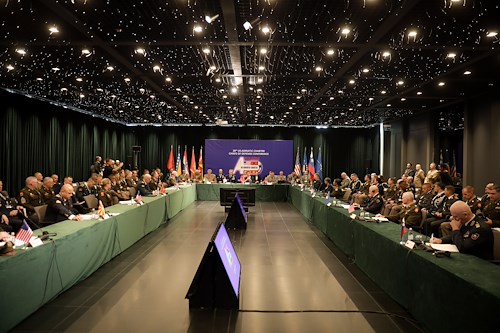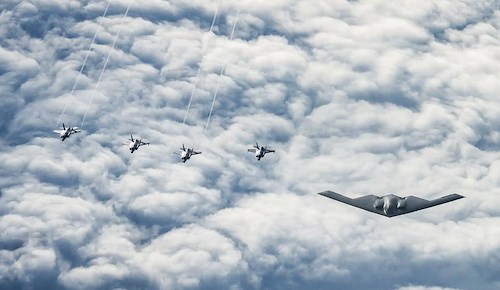Gallery contains 2 images
×
Photo 1 of 2
An unmatched force: U.S. industry, military leaders tackle current, future battlefield needs
U.S. Army Gen. Christopher Cavoli, commander of U.S. European Command and Supreme Allied Commander Europe, speaks virtually to attendees of the National Defense Industrial Association’s Emerging Technologies for Defense & Exhibition Conference, Aug. 7-9, 2024, in Washington, D.C.
Photo by: Courtesy of NDIA
Photo 2 of 2
An unmatched force: U.S. industry, military leaders tackle current, future battlefield needs
USEUCOM’s Director for Requirements and Resource Integration Sally Pfenning led a delegation of some 20 subject-matter experts from the command’s warfighting headquarters in Stuttgart, Germany, to the National Defense Industrial Association’s Emerging Technologies for Defense & Exhibition Conference, Aug. 7-9, 2024, in Washington, D.C.
Photo by: U.S. European Command Public Affairs
While 5,000 miles separated Ukraine’s battlefields from America’s capital city, the lessons learned from that ongoing war were very much present as nearly 1,000 business, government and academic senior executives congregated for the National Defense Industrial Association’s Emerging Technologies for Defense & Exhibition Conference, Aug. 7-9, 2024, in Washington, D.C.
Government leaders – from the Pentagon and the White House’s Office of Science and Technology Policy to Stuttgart, Germany-headquartered combatant commands of U.S. European Command (USEUCOM) and U.S. Africa Command – discussed how the U.S. Defense Department and industry can partner to transition critical technologies into production and ultimate deployment to meet current and future operational challenges.
“We are aggressively expanding relationships with concept developers, prototyping organizations, national laboratories and our partners and Allies,” said Sally Pfenning, USEUCOM’s Senior Executive Service-level director for requirements and resource integration, who led a delegation of some 20 subject-matter experts from the command’s warfighting headquarters. “We must embrace the speed of commercial technology, managing the accompanying risk, but exploiting the inherent opportunities.”
In his formal remarks delivered virtually from the Supreme Headquarters Allied Powers Europe headquarters in Mons, Belgium, USEUCOM’s commanding general and commander of NATO forces, U.S. Army Gen. Christopher Cavoli, underscored the critical role the defense industrial base plays to help America’s military forces and those of Allies and partners confront the dynamic challenges of today and beyond.
“It appears to me that the advantage is going to go now, and in the foreseeable future, to the side that's able to mix a certain amount of high or moderately high tech into their legacy systems,” Cavoli said. “And do it in a clever way that can be adapted rapidly.”
One of the most compelling aspects of the high-level conference was the cross-pollinating nature of both formal presentations and sideline discussions in helping industry better understand the technological challenges that the two Germany-based U.S. geographic combatant commands face, along with the sought-after solutions.
Pfenning and her delegation led a robust schedule of industry engagements to dialogue directly with industry representatives on partnership opportunities.
“U.S. European Command has shifted from a security cooperation structure and function to a warfighting headquarters that is mirroring what NATO is doing: changing from security cooperation and small-scale missions to an overall collective defense structure,” she said.
That, in turn, has impacted the command’s capability and technology needs, she explained, in everything from innovation and technology initiatives to counter-Unmanned Aerial Systems and the command’s fires network.
“It is critically important that we get this right because I believe that industrial production of defense articles is a critical part of our integrated deterrence,” Cavoli added. “And if we want to keep peace in the world, we're going to have to get the industrial part of it right as well. That’s why this dialogue is so important.”










